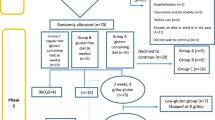Abstract
Objectives:
This study estimates the prevalence of perceived food intolerance and its consequences in subjects with irritable bowel syndrome (IBS), evaluates the utility of common tests for food intolerance, studies the relation between perceived food intolerance and other disorders, and discusses the etiology.
Design:
Cross-sectional study.
Setting:
National health survey.
Subjects:
A selection of the population (n=11078) in Oppland county, Norway, was invited to a health screening, and a sample of subjects with IBS were included in the study.
Interventions:
A medical history of food intolerance, musculoskeletal pain, mood disorders and abdominal complaints was taken, and tests were performed for food allergy and malabsorption. A dietician evaluated the dietary habits of the subjects.
Results:
Out of 4622 subjects with adequately filled-in questionnaires, 84 were included in the study, 59 (70%) had symptoms related to intake of food, 62% limited or excluded food items from the diet and 12% had an inadequate diet. The mean numbers of food items related to symptoms and the number of foods limited or excluded from the diet were 4.8 and 2.5, respectively. There were no associations between the tests for food allergy and malabsorption and perceived food intolerance. Perceived food intolerance was unrelated to musculoskeletal pain and mood disorders.
Conclusions:
Perceived food intolerance is a common problem with significant nutritional consequences in a population with IBS. The uselessness of current antibody tests and tests for malabsorption and the lack of correlation to psychiatric co-morbidity make the etiology obscure.
Sponsorship:
Innlandet Hospital Health Authority, Norway.
This is a preview of subscription content, access via your institution
Access options
Subscribe to this journal
Receive 12 print issues and online access
$259.00 per year
only $21.58 per issue
Buy this article
- Purchase on SpringerLink
- Instant access to full article PDF
Prices may be subject to local taxes which are calculated during checkout


Similar content being viewed by others
References
Barbara G, De Giorgio R, Stanghellini V, Cremon C, Corinaldesi R (2002). A role for inflammation in irritable bowel syndrome? Gut 51 (Suppl 1), i41–i44.
Dainese R, Galliani EA, De Lazzari FD, Leo VD, Naccarato R (1999). Discrepancies between reported food intolerance and sensitization test findings in irritable bowel syndrome patients. Am J Gastroenterol 94, 1892–1897.
Farup PG, Monsbakken KW, Vandvik PO (2004). Lactose malabsorption in a population with irritable bowel syndrome: prevalence and symptoms. A case–control study. Scand J Gastroenterol 39, 645–649.
Gislason D, Bjornsson E, Gislason T, Janson C, Sjoberg O, Elfman L et al. (1999). Sensitization to airborne and food allergens in Reykjavik (Iceland) and Uppsala (Sweden) – a comparative study. Allergy 54, 1160–1167.
Isolauri E, Rautava S, Kalliomaki M (2004). Food allergy in irritable bowel syndrome: new facts and old fallacies. Gut 53, 1391–1393.
Jones J, Boorman J, Cann P, Forbes A, Gomborone J, Heaton K et al. (2000). British Society of Gastroenterology guidelines for the management of the irritable bowel syndrome. Gut 47 (Suppl 2), ii1–ii19.
Knibb RC, Armstrong A, Booth DA, Platts RG, Booth IW, MacDonald A (1999). Psychological characteristics of people with perceived food intolerance in a community sample. J Psychosom Res 47, 545–554.
Locke GR, Zinsmeister AR, Talley NJ, Fett SL, Melton LJ (2000). Risk factors for irritable bowel syndrome: role of analgesics and food sensitivities. Am J Gastroenterol 95, 157–165.
Nanda R, James R, Smith H, Dudley CR, Jewell DP (1989). Food intolerance and the irritable bowel syndrome. Gut 30, 1099–1104.
Neri M, Laterza F, Howell S, Di Gioacchino M, Festi D, Ballone E et al. (2000). Symptoms discriminate irritable bowel syndrome from organic gastrointestinal diseases and food allergy. Eur J Gastroenterol Hepatol 12, 981–988.
Ortolani C, Bruijnzeel-Koomen C, Bengtsson U, Bindslev-Jensen C, Bjorksten B, Host A et al. (1999). Controversial aspects of adverse reactions to food. European Academy of Allergology and Clinical Immunology (EAACI) Reactions to Food Subcommittee. Allergy 54, 27–45.
Peveler R, Mayou R, Young E, Stoneham M (1996). Psychiatric aspects of food-related physical symptoms: a community study. J Psychosom Res 41, 149–159.
Posserud I, Agerforz P, Ekman R, Bjornsson ES, Abrahamsson H, Simren M (2004). Altered visceral perceptual and neuroendocrine response in patients with irritable bowel syndrome during mental stress. Gut 53, 1102–1108.
Rix KJ, Pearson DJ, Bentley SJ (1984). A psychiatric study of patients with supposed food allergy. Br J Psychiatry 145, 121–126.
Sanders DS, Carter MJ, Hurlstone DP, Pearce A, Ward AM, McAlindon ME et al. (2001). Association of adult coeliac disease with irritable bowel syndrome: a case–control study in patients fulfilling ROME II criteria referred to secondary care. Lancet 358, 1504–1508.
Simren M, Abrahamsson H, Bjornsson ES (2001a). An exaggerated sensory component of the gastrocolonic response in patients with irritable bowel syndrome. Gut 48, 20–27.
Simren M, Mansson A, Langkilde AM, Svedlund J, Abrahamsson H, Bengtsson U et al. (2001b). Food-related gastrointestinal symptoms in the irritable bowel syndrome. Digestion 63, 108–115.
Sogaard AJ, Selmer R, Bjertness E, Thelle D (2004). The Oslo Health Study: the impact of self-selection in a large, population-based survey. Int J Equity Health 3, 3.
Strand BH, Dalgard OS, Tambs K, Rognerud M (2003). Measuring the mental health status of the Norwegian population: a comparison of the instruments SCL-25, SCL-10, SCL-5 and MHI-5 (SF-36). Nord J Psychiatry 57, 113–118.
Thompson WG, Irvine EJ, Pare P, Ferrazzi S, Rance L (2002). Functional gastrointestinal disorders in Canada: first population-based survey using Rome II criteria with suggestions for improving the questionnaire. Digest Dis Sci 47, 225–235.
Vandvik PO, Farup PG (2004). Irritable bowel syndrome in a Norwegian population: prevalence and association with mood disorders and musculoskeletal complaints. Gastroenterology 126 (Suppl 2), A-478.
Vandvik PO, Wilhelmsen I, Ihlebaek C, Farup PG (2004). Comorbidity of irritable bowel syndrome in general practice: a striking feature with clinical implications. Aliment Pharmacol Ther 20, 1195–1203.
Young E, Stoneham MD, Petruckevitch A, Barton J, Rona R (1994). A population study of food intolerance. Lancet 343, 1127–1130.
Zar S, Kumar D, Benson MJ (2001). Food hypersensitivity and irritable bowel syndrome. Aliment Pharmacol Ther 15, 439–449.
Acknowledgements
We wish to thank the Norwegian Institute of Public Health for inviting us to participate in the health study and for pleasant collaboration, Fürst Medisinsk Laboratorium, Søren Bulls vei 25, 1051 Oslo, for permission to publish the results from the analyses of food antibodies, and Innlandet Hospital Health Authority, Norway for grants.
Author information
Authors and Affiliations
Corresponding author
Additional information
Guarantor: PG Farup.
Contributors: KWM wrote the protocol that was designed in collaboration by all the authors. KWM was the dietician responsible for the patients and collected all the information about dietary habits; POV was the physician responsible for the patients and collected the medical information. KWM and POV were responsible for the clean data file. PGF performed the statistical analyses and wrote the paper, which was critically revised and approved by all the authors.
Rights and permissions
About this article
Cite this article
Monsbakken, K., Vandvik, P. & Farup, P. Perceived food intolerance in subjects with irritable bowel syndrome – etiology, prevalence and consequences. Eur J Clin Nutr 60, 667–672 (2006). https://doi.org/10.1038/sj.ejcn.1602367
Received:
Revised:
Accepted:
Published:
Issue Date:
DOI: https://doi.org/10.1038/sj.ejcn.1602367


